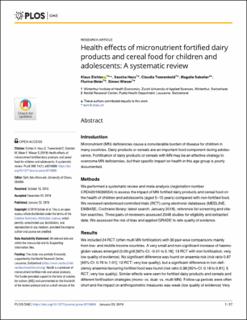Please use this identifier to cite or link to this item:
https://doi.org/10.21256/zhaw-5014Full metadata record
| DC Field | Value | Language |
|---|---|---|
| dc.contributor.author | Eichler, Klaus | - |
| dc.contributor.author | Hess, Sascha | - |
| dc.contributor.author | Twerenbold, Claudia | - |
| dc.contributor.author | Sabatier, Magalie | - |
| dc.contributor.author | Meier, Flurina | - |
| dc.contributor.author | Wieser, Simon | - |
| dc.date.accessioned | 2019-02-11T14:29:37Z | - |
| dc.date.available | 2019-02-11T14:29:37Z | - |
| dc.date.issued | 2019 | - |
| dc.identifier.issn | 1932-6203 | de_CH |
| dc.identifier.uri | https://digitalcollection.zhaw.ch/handle/11475/15257 | - |
| dc.description.abstract | Introduction: Micronutrient (MN) deficiencies cause a considerable burden of disease for children in many countries. Dairy products or cereals are an important food component during adolescence. Fortification of dairy products or cereals with MN may be an effective strategy to overcome MN deficiencies, but their specific impact on health in this age group is poorly documented. Methods: We performed a systematic review and meta-analysis (registration number CRD42016039554) to assess the impact of MN fortified dairy products and cereal food on the health of children and adolescents (aged 5–15 years) compared with non-fortified food. We reviewed randomised controlled trials (RCT) using electronic databases (MEDLINE, EMBASE, Cochrane library; latest search: January 2018), reference list screening and citation searches. Three pairs of reviewers assessed 2048 studies for eligibility and extracted data. We assessed the risk of bias and applied GRADE to rate quality of evidence. Results: We included 24 RCT (often multi MN fortification) with 30 pair-wise comparisons mainly from low- and middle income countries. A very small and non-significant increase of haemoglobin values emerged (0.09 g/dl [95%-CI: -0.01 to 0.18]; 13 RCT with iron fortification; very low quality of evidence). No significant difference was found on anaemia risk (risk ratio 0.87 [95%-CI: 0.76 to 1.01]; 12 RCT; very low quality), but a significant difference in iron deficiency anaemia favouring fortified food was found (risk ratio 0.38 [95%-CI: 0.18 to 0.81]; 5 RCT; very low quality). Similar effects were seen for fortified dairy products and cereals and different fortification strategies (mono- vs. dual- vs. multi-MN). Follow-up periods were often short and the impact on anthropometric measures was weak (low quality of evidence) Very low quality of evidence emerged for the improvement of cognitive performance, functional measures and morbidity. Conclusions: Fortification of dairy products and cereal food had only marginal health effects in our sample population from 5-15 years. Further evidence is needed to better understand the health impact of fortified dairy products and cereals in this age group. | de_CH |
| dc.language.iso | en | de_CH |
| dc.publisher | Public Library of Science | de_CH |
| dc.relation.ispartof | PLOS ONE | de_CH |
| dc.rights | http://creativecommons.org/licenses/by/4.0/ | de_CH |
| dc.subject | Micronutrients | de_CH |
| dc.subject | Fortification | de_CH |
| dc.subject | Deficiencies | de_CH |
| dc.subject | Children | de_CH |
| dc.subject | Adolescents | de_CH |
| dc.subject.ddc | 613.2: Diätetik | de_CH |
| dc.title | Health effects of micronutrient fortified dairy products and cereal food for children and adolescents : a systematic review | de_CH |
| dc.type | Beitrag in wissenschaftlicher Zeitschrift | de_CH |
| dcterms.type | Text | de_CH |
| zhaw.departement | School of Management and Law | de_CH |
| zhaw.organisationalunit | Winterthurer Institut für Gesundheitsökonomie (WIG) | de_CH |
| dc.identifier.doi | 10.1371/journal.pone.0210899 | de_CH |
| dc.identifier.doi | 10.21256/zhaw-5014 | - |
| dc.identifier.pmid | 30673769 | de_CH |
| zhaw.funding.eu | No | de_CH |
| zhaw.issue | 1 | de_CH |
| zhaw.originated.zhaw | Yes | de_CH |
| zhaw.publication.status | publishedVersion | de_CH |
| zhaw.volume | 14 | de_CH |
| zhaw.publication.review | Peer review (Publikation) | de_CH |
| zhaw.webfeed | Ernährung | de_CH |
| Appears in collections: | Publikationen School of Management and Law | |
Files in This Item:
| File | Description | Size | Format | |
|---|---|---|---|---|
| 2019_Eichler_Health_effects_of_micronutrient_fortified_dairy_products.pdf | 1.37 MB | Adobe PDF |  View/Open |
Show simple item record
Eichler, K., Hess, S., Twerenbold, C., Sabatier, M., Meier, F., & Wieser, S. (2019). Health effects of micronutrient fortified dairy products and cereal food for children and adolescents : a systematic review. Plos One, 14(1). https://doi.org/10.1371/journal.pone.0210899
Eichler, K. et al. (2019) ‘Health effects of micronutrient fortified dairy products and cereal food for children and adolescents : a systematic review’, PLOS ONE, 14(1). Available at: https://doi.org/10.1371/journal.pone.0210899.
K. Eichler, S. Hess, C. Twerenbold, M. Sabatier, F. Meier, and S. Wieser, “Health effects of micronutrient fortified dairy products and cereal food for children and adolescents : a systematic review,” PLOS ONE, vol. 14, no. 1, 2019, doi: 10.1371/journal.pone.0210899.
EICHLER, Klaus, Sascha HESS, Claudia TWERENBOLD, Magalie SABATIER, Flurina MEIER und Simon WIESER, 2019. Health effects of micronutrient fortified dairy products and cereal food for children and adolescents : a systematic review. PLOS ONE. 2019. Bd. 14, Nr. 1. DOI 10.1371/journal.pone.0210899
Eichler, Klaus, Sascha Hess, Claudia Twerenbold, Magalie Sabatier, Flurina Meier, and Simon Wieser. 2019. “Health Effects of Micronutrient Fortified Dairy Products and Cereal Food for Children and Adolescents : A Systematic Review.” Plos One 14 (1). https://doi.org/10.1371/journal.pone.0210899.
Eichler, Klaus, et al. “Health Effects of Micronutrient Fortified Dairy Products and Cereal Food for Children and Adolescents : A Systematic Review.” Plos One, vol. 14, no. 1, 2019, https://doi.org/10.1371/journal.pone.0210899.
Items in DSpace are protected by copyright, with all rights reserved, unless otherwise indicated.